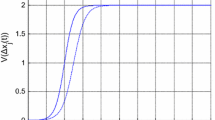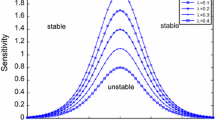Abstract
A modified optimal velocity model is proposed by considering the timid or aggressive characteristics of drivers behavior on traffic flow. The effect of driver’s characteristic on the stability of traffic flow under honk environment is examined through linear stability analysis. It is shown that the parameters related to driver’s characteristics and honk effect all have significant impact on the stability of traffic flow. Precisely, the timid driver is more beneficial to improve the stability of the traffic flow than the aggressive one under honk environment; moreover, the more skillful driver is more advantageous to improve the stability of traffic situation under the same honk environment for the same driver’s characteristics. Finally, many simulation results are found consistent with the theoretical findings which confirm that the drivers characteristics play a significant role on traffic flow dynamics.










Similar content being viewed by others
References
Bando, M., Hasebe, K., Nakayama, A., Shibata, A., Sugiyama, Y.: Dynamical model of traffic congestion and numerical simulation. Phys. Rev. E 51, 1035–1042 (1995)
Helbing, D., Tilch, B.: Generalized force model of traffic dynamics. Phys. Rev. E 58, 133–138 (1998)
Jiang, R., Wu, Q., Zhu, Z.: Full velocity difference model for a car-following theory. Phys. Rev. E 64, 017101 (2001)
Nakayama, A., Sugiyama, Y., Hasebe, K.: Effect of looking at the car that follows in an optimal velocity model of traffic flow. Phys. Rev. E 65, 016112 (2001)
Li, X., Li, Z., Han, X., Dai, S.: Effect of the optimal velocity function on traffic phase transitions in lattice hydrodynamic models. Commun. Nonliear Sci. Numer. Simul. 14, 2171–2177 (2009)
Tang, T.Q., Li, C.Y., Wu, Y.H., Huang, H.J.: Impact of the honk effect on the stability of traffic flow. Phys. A 390, 3362–3368 (2011)
Peng, G., Cheng, R.: A new car-following model with the consideration of anticipation optimal velocity. Phys. A Stat. Mech. Appl. 392, 3563–3569 (2013)
Davis, L.C.: Modifications of the optimal velocity traffic model to include delay due to driver reaction time. Phys. A 319, 557–567 (2003)
Peng, G.H., Sun, D.H.: A dynamical model of car-following with the consideration of the multiple information of preceding cars. Phys. Lett. A 374, 1694–1698 (2010)
Tang, T., Wang, Y., Yang, X., Wu, Y.: A new car-following model accounting for varying road condition. Nonlinear Dyn. 70, 1397–1405 (2012)
Nagatani, T.: Density waves in traffic flow. Phys. Rev. E 61, 3564–3570 (1999)
Zhao, X., Gao, Z.: A new car-following model: full velocity and acceleration difference model. Eur. Phys. J. B 47, 145–150 (2005)
Tang, T., Shi, W., Shang, H., Wang, Y.: A new car-following model with consideration of inter-vehicle communication. Nonlinear Dyn. 76, 2017–2023 (2014)
Tang, T.Q., Li, C.Y., Huang, H.J.: A new car-following model with the consideration of the drivers forecast effect. Phys. Lett. A 374, 3951–3956 (2010)
Kerner, B.S., Klenov, S.L., Hermanns, G., Schreckenberg, M.: Effect of driver over-acceleration on traffic breakdown in three-phase cellular automaton traffic flow models. Phys. A 392, 4083–4105 (2013)
Sharma, S.: Lattice hydrodynamic modeling of two-lane traffic flow with timid and aggressive driving behavior. Phys. A 421, 401–411 (2015)
Kang, Y.-R., Sun, D.-H.: Lattice hydrodynamic traffic flow model with explicit drivers physical delay. Nonlinear Dyn. 71, 531–537 (2013)
Chen, D., Ahn, S., Laval, J., Zheng, Z.: On the periodicity of traffic oscillations and capacity drop: the role of driver characteristics. Transp. Res. Part B 59, 117–136 (2014)
Cheng, R.-J., Li, Z.-P., Zheng, P.-J., Ge, H.-X.: The theoretical analysis of the anticipation lattice models for traffic flow. Nonliear Dyn. 76, 725–731 (2014)
Zhang, H.M., Kim, T.: A car-following theory for multiphase vehicular traffic flow. Transp. Res. Part B 39, 385–399 (2005)
Tang, T., Li, C., Huang, H., Shang, H.: A new fundamental diagram theory with the individual difference of the drivers perception ability. Nonlinear Dyn. 67, 2255–2265 (2012)
Sharma, S.: Effect of drivers anticipation in a new two-lane lattice model with the consideration of optimal current difference. Nonlinear Dyn. 81, 991–1003 (2015)
Gupta, A.K., Redhu, P.: Analyses of drivers anticipation effect in sensing relative flux in a new lattice model for two-lane traffic system. Phys. A 392, 5622–5632 (2013)
Acknowledgments
The study is supported by the National Natural Science Foundation of China (Nos. 51578247, 11501216), Science and Technology Plan Project of Guangdong Province (2013B010401009), China Postdoctoral Science Foundation Funded Project (2015M570716).
Author information
Authors and Affiliations
Corresponding author
Rights and permissions
About this article
Cite this article
Wen, H., Rong, Y., Zeng, C. et al. The effect of driver’s characteristics on the stability of traffic flow under honk environment. Nonlinear Dyn 84, 1517–1528 (2016). https://doi.org/10.1007/s11071-015-2585-0
Received:
Accepted:
Published:
Issue Date:
DOI: https://doi.org/10.1007/s11071-015-2585-0




